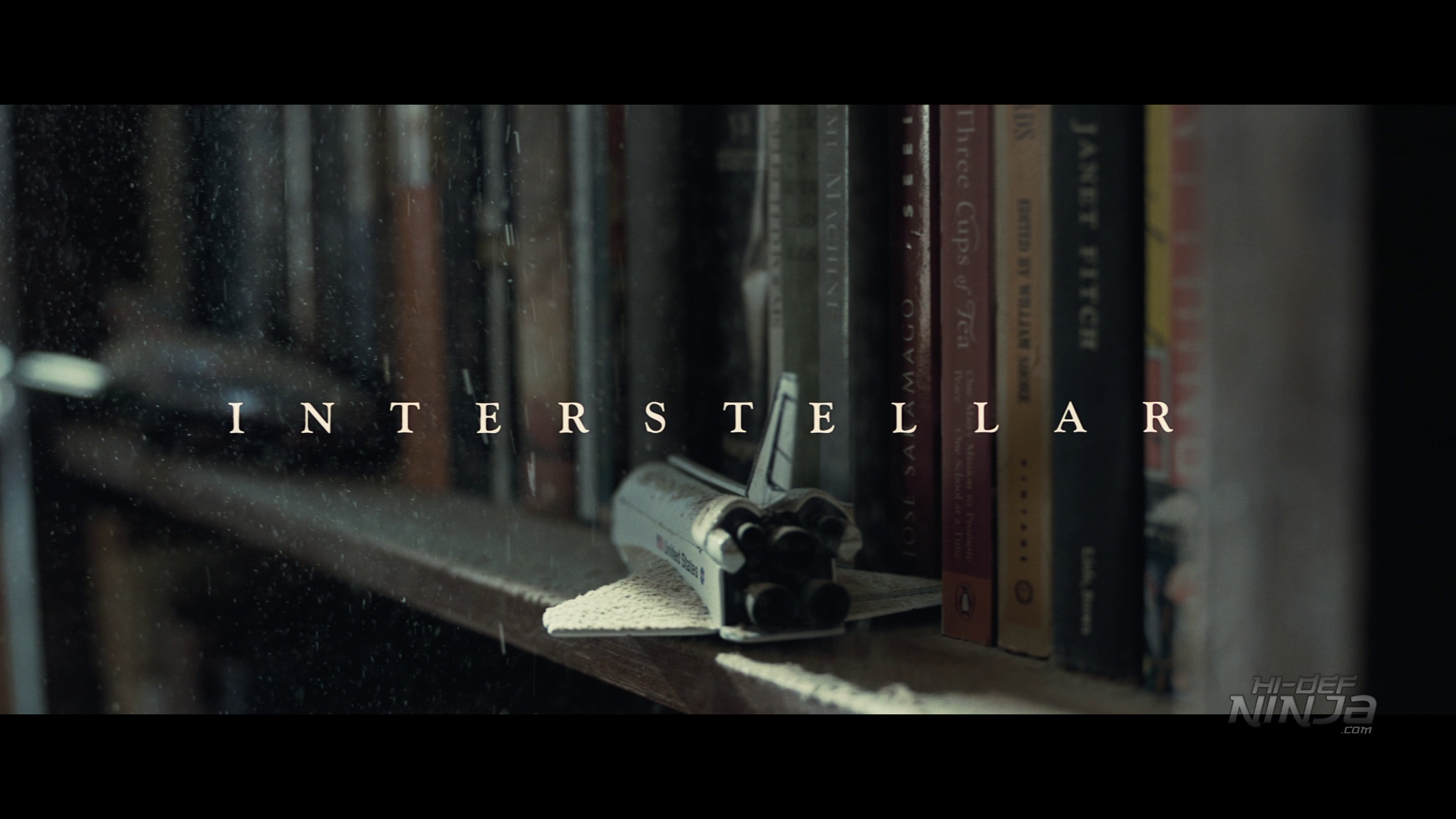INTERSTELLAR looks amazing, but its audio issues prevent a perfect score.
Man’s journey to the stars was sadly put in neutral after 2011 when the Space Shuttle Atlantis completed the final mission of the famed program. Although we have created a new vehicle to ascend into space, it will be years before Orion is ready to pick up where the shuttles left off. In the epic space adventure INTERSTELLAR, we imagine a world in which that dream is long-since gone, replaced with a worldwide catastrophe that will end man’s time on Earth. Luckily for us, we can now enjoy the powerful experience of director Christopher Nolan’s film at home, with a presentation that looks great, is filled with a tremendous amount of special features, but whose audio and plot still confuse the hell out of most people hoping for another THE DARK KNIGHT masterpiece.

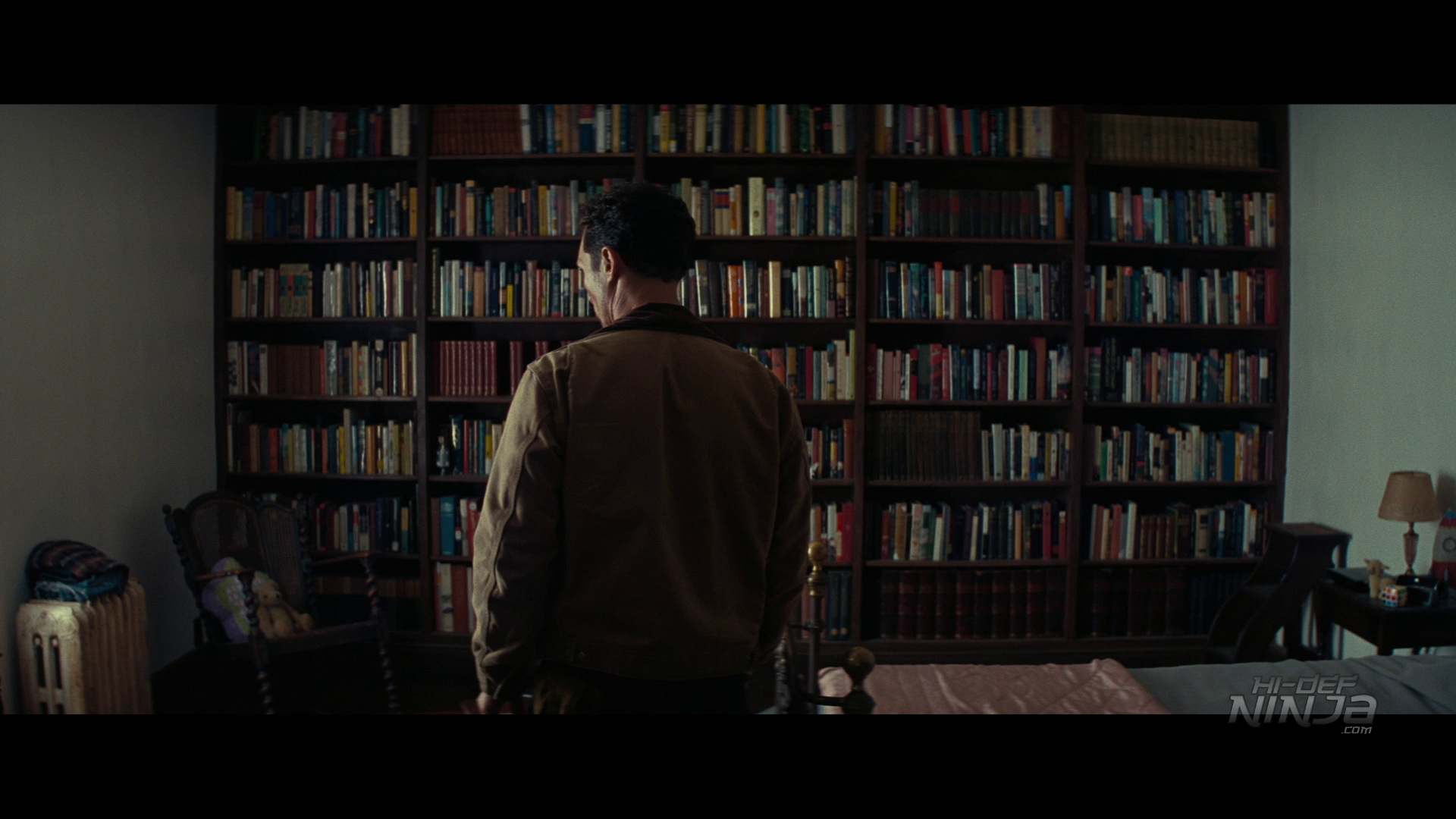 Having polluted the Earth beyond its ability to recover, a disease called Blight has destroyed the world’s crops until corn is all that’s left. For former astronaut Cooper (Matthew McConaughey), life as a farmer hasn’t been without its challenge, as the recent death of his wife has left him with teenagers Tom (Timothée Chalamet) and the bright Murph (Mackenzie Foy), who’s recently been suspended for arguing that the Apollo moon missions were in fact real. When a poltergeist-like event occurs in their library – where several books and a model have inexplicably fallen off the shelves – Cooper and Murph realize that it’s actually a message and a location, which leads them back to Cooper’s old boss Professor Brand (Michael Caine). There, Cooper is told two unshakable facts: the Earth will end with Murph’s generation, and Cooper is the only one who can save the human race. Via a wormhole that has appeared near Saturn, Cooper and his team (including Anne Hathaway, Wes Bentley, and David Gyasi) journey to three potential planets on the other side of space-time, seeking the original astronauts who ventured out years before, but who have not been heard from since. Along the way, Cooper and his colleagues will witness the very wonders of the cosmos and endure unimaginable danger, while humanity itself teeters on the edge of oblivion.
Having polluted the Earth beyond its ability to recover, a disease called Blight has destroyed the world’s crops until corn is all that’s left. For former astronaut Cooper (Matthew McConaughey), life as a farmer hasn’t been without its challenge, as the recent death of his wife has left him with teenagers Tom (Timothée Chalamet) and the bright Murph (Mackenzie Foy), who’s recently been suspended for arguing that the Apollo moon missions were in fact real. When a poltergeist-like event occurs in their library – where several books and a model have inexplicably fallen off the shelves – Cooper and Murph realize that it’s actually a message and a location, which leads them back to Cooper’s old boss Professor Brand (Michael Caine). There, Cooper is told two unshakable facts: the Earth will end with Murph’s generation, and Cooper is the only one who can save the human race. Via a wormhole that has appeared near Saturn, Cooper and his team (including Anne Hathaway, Wes Bentley, and David Gyasi) journey to three potential planets on the other side of space-time, seeking the original astronauts who ventured out years before, but who have not been heard from since. Along the way, Cooper and his colleagues will witness the very wonders of the cosmos and endure unimaginable danger, while humanity itself teeters on the edge of oblivion.
Even after months of discussion – from the scientific community to those at the 2015 Oscars – INTERSTELLAR is still a tough movie to nail down. Is it a sweeping space epic where love is as constant as gravity? Is it a scientific and political commentary on where the human race is headed? Or is it an amalgam of several different plots, Frankenstein-ed together with science and incredible sensory experiences? Adding to that conundrum, we get slam-dunked on theories like Einstein’s Special Theory of Relativity, dimensional gravity, and the effect of black holes on humans, while the drama of space exploration and the wonders therein try to keep up. My opinion of INTERSTELLAR has changed somewhat since I saw it (twice) in theaters, due entirely to my repeat watchings at home. I had the same reaction until I viewed 2001 over the years, my love for it growing each time. To appreciate the beauty and wonder which INTERSTELLAR boldly embarks upon, one must see it as an evolution instead of trying to catch all that matter through a beaker.
Nolan certainly commands this production like a scientist – and hearing him in the supplements does prove how brilliant a filmmaker he is – while his technical know-how has definitely evolved. He’s perhaps the top director of our time, and yet the film won’t make converts out of everyone. Penned by his PERSON OF INTEREST brother Jonathon, INTERSTELLAR misses the human portion, at first making Cooper and Murph’s relationship center to the story, while never piecing it back together as the two are literally in different dimensions by the end. The way Murph ultimately dismisses Cooper to find Amelia is surprising, considering all the hate she stomached through Acts 1 & 2. The emotion and danger of space travel do give us some good scenes between Cooper and Amelia, but it ultimately feels a bit cold and therefore less genuine. There’s also several convenient plot devices that seem to place Cooper in the right place at the right time in order to keep the story from getting lost in space. These WTF moments happen too often, are not explained simply enough, and remind us that good story telling relies on showing – not telling – us how these elements fit into the greater plot. The best cast of 2014 isn’t used as effectively as they could, including Murph’s older iteration played by Jessica Chastain, who harbors deep but overly simplified resentment towards her father. Instead of working to find a way to communicate with him – as he does through space-time in the climax – she sends angry messages to him with no idea of whether they are ever actually received.
If you like a lot of silent exposition – as astronauts push buttons and look stressed while ships float through space – with many basic questions never answered, you’ll find a home here. What does the Earth resemble in the future? Why doesn’t Cooper use the same wormhole to begin searching for his lost crew/love? Why should we care about Amelia and her fate in the first place, when she has all the human eggs with her and CASE the metallic robot? Granted, that would have resulted in a four-hour film, but when you raise the questions, you have to answer them. If you’re not of a scientific mind – as I sadly seem to be no matter how hard I try – INTERSTELLAR will feel like you’ve been at someone’s home who speaks a totally different language than you.
And then there’s the brash, beautiful, and sometimes oppressively loud music by Composer Hans Zimmer, his soundtrack crossing the barriers of traditional scores into a realm that might outlive his already impressive resume. And yet with all those missteps, INTERSTELLAR should be seen, owned, and discussed around water coolers as much as the most recent gossip and entertainment news. Scientist and technical adviser Kip Thorne lends a credibility that legitimizes nearly everything, from the space suits to the warping around Gargantua. This should hold up nicely as the decades go on, taking its place among the classics, so long as you can get past the galaxy-sized plot holes. With the Fox program COSMOS (see our review here) firing the imagination of kids everywhere, INTERSTELLAR should go one step further to encourage all of us to look to the stars for our future, instead of petty territorial disagreements and the minutia of our daily lives.

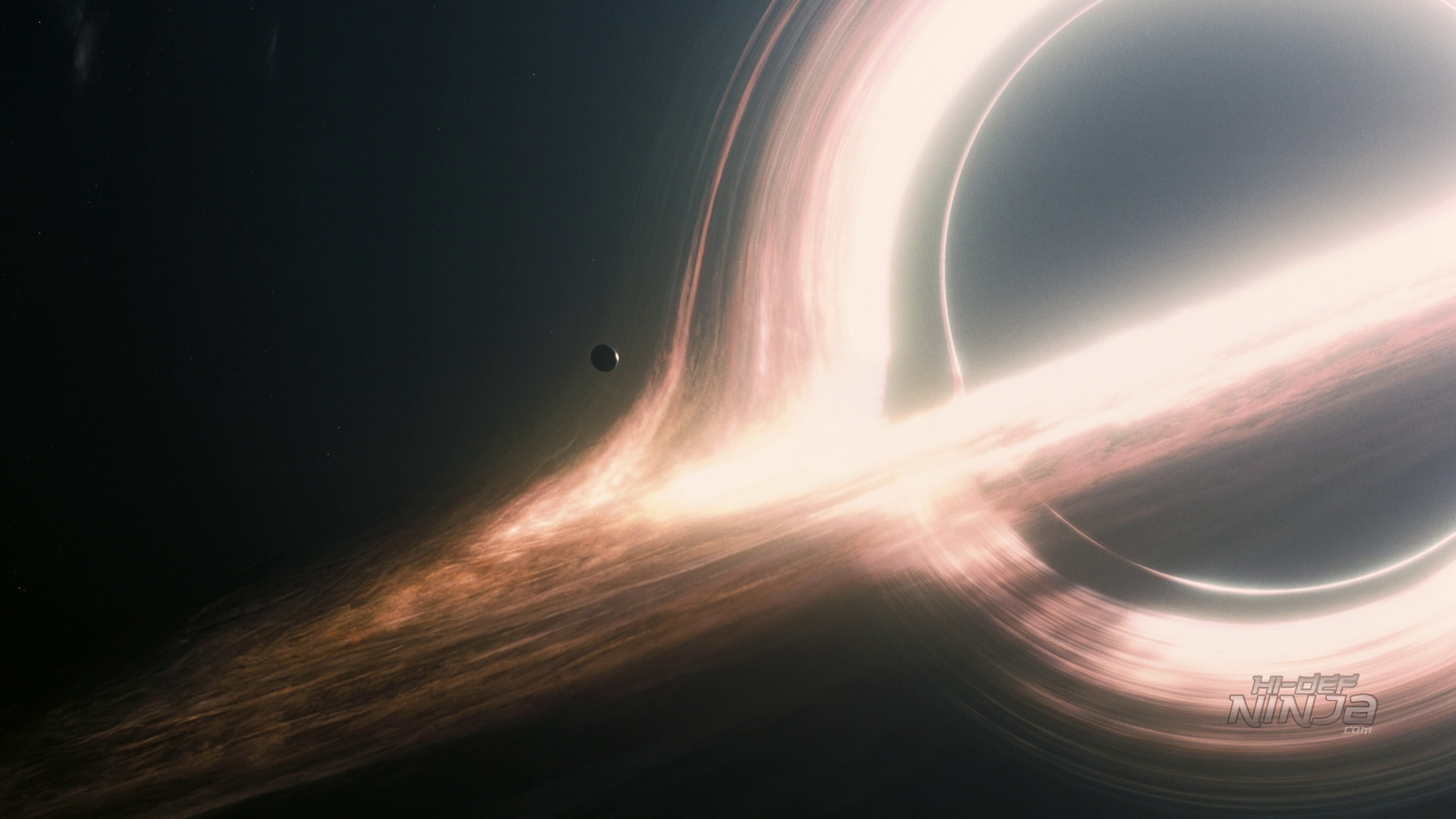 INTERSTELLAR arrives with a beautiful MPEG-4/AVC transfer that’s supple in its tones one minute, harsh and unforgiving the next, but always stunning in its clarity. Any complaints about the transitions between IMAX and the traditional widescreen are unfounded, leaving the print better than when we saw it in theaters. There is a beauty to the print that high-definition platforms will thrive on, revealing transitions between light and shadow that come from Nolan’s use of a hybrid of practical and digital effects. Some blacks and whites are washed out, but that’s not Paramount’s fault – they reproduce his world with stunning details that were initially missed on dirty white screens in old theaters slow to adapt to technology. There is a definite difference between the slightly oversaturated Earth tones of flesh, green crops, and clothing and the stark patterns which emerge as we begin to visit the worlds beyond the wormhole. You might read that some critics witnessed hairs on the print, but I could not find them on either the BD or the DVD. I’m not criticizing anyone, but I looked through that sequence several times and did not see it. Detail is extraordinary throughout, revealing a dirty and well-worn Endurance, a Blight-filled Earth with individual grains of dust fairly apparent as you get into closeups, and breathtaking imagery of Gargantua. Human features are just as striking, such as the sweat on Cooper’s face, the huge waves on Miller’s Planet, and the various interiors and clothing of our astronauts. If you do see the technical issues some critics are observing, do let us know in the comments section below. But at this point, INTERSTELLAR is gorgeous and receives high marks.
INTERSTELLAR arrives with a beautiful MPEG-4/AVC transfer that’s supple in its tones one minute, harsh and unforgiving the next, but always stunning in its clarity. Any complaints about the transitions between IMAX and the traditional widescreen are unfounded, leaving the print better than when we saw it in theaters. There is a beauty to the print that high-definition platforms will thrive on, revealing transitions between light and shadow that come from Nolan’s use of a hybrid of practical and digital effects. Some blacks and whites are washed out, but that’s not Paramount’s fault – they reproduce his world with stunning details that were initially missed on dirty white screens in old theaters slow to adapt to technology. There is a definite difference between the slightly oversaturated Earth tones of flesh, green crops, and clothing and the stark patterns which emerge as we begin to visit the worlds beyond the wormhole. You might read that some critics witnessed hairs on the print, but I could not find them on either the BD or the DVD. I’m not criticizing anyone, but I looked through that sequence several times and did not see it. Detail is extraordinary throughout, revealing a dirty and well-worn Endurance, a Blight-filled Earth with individual grains of dust fairly apparent as you get into closeups, and breathtaking imagery of Gargantua. Human features are just as striking, such as the sweat on Cooper’s face, the huge waves on Miller’s Planet, and the various interiors and clothing of our astronauts. If you do see the technical issues some critics are observing, do let us know in the comments section below. But at this point, INTERSTELLAR is gorgeous and receives high marks.

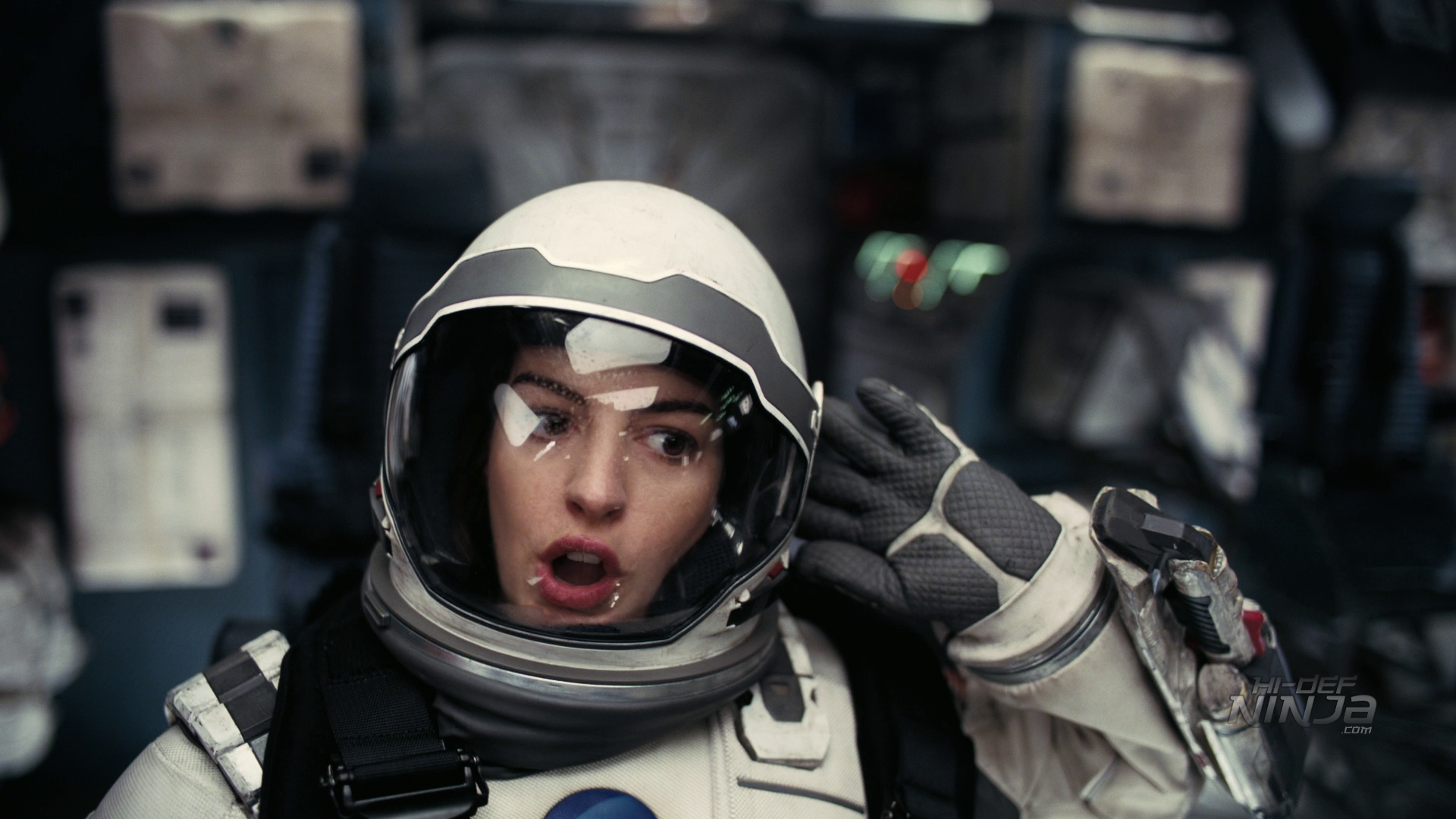 INTERSTELLAR flies in with a DTS-HD Master Audio 5.1 track that should have been a 7.1. but displays a rich environment nevertheless. From the moment we visit Cooper’s memory of the failed test flight, it’s clear that Paramount has something special planned…at points. The entire soundfield is on display here, from the large-scale booming of the NASA rocket launch to the dust storms which plague Earth in the first act. There’s also a lot of subtlety to the track: crowd noise, the beeping/booping of instruments, and footsteps show up frequently. Forward speakers deliver the requisite music and sound effects, all of which come across quite beautifully, while the channel provides us with nothing but dialogue. And that’s the problem: in those moments where the scene is quiet, it’s very difficult to hear McConagey’s mumbling and even some of Hathaway’s nearly scientific tones. Some will be off-put some in trying to play The Remote Game, suddenly finding themselves dialing it back when Zimmer’s thunderous – and frankly overpowering – score arrives. Zimmer should have won at the 2015 Oscars, his use of pipe organs elevating soundtracks to a whole new level. But I found myself yelling over it many times to debate with my wife the precepts of the film instead of normally enjoying the audio presentation. After reading other reviews, I feel better in laying down some criticism that was just as loud in IMAX and XD when it premiered in theaters. Still, I think very highly of Paramount’s efforts to bring Nolan’s awe-inspiring production to the home, with mostly precise, clear sounds that will make any home theater shake, rattle, and roll.
INTERSTELLAR flies in with a DTS-HD Master Audio 5.1 track that should have been a 7.1. but displays a rich environment nevertheless. From the moment we visit Cooper’s memory of the failed test flight, it’s clear that Paramount has something special planned…at points. The entire soundfield is on display here, from the large-scale booming of the NASA rocket launch to the dust storms which plague Earth in the first act. There’s also a lot of subtlety to the track: crowd noise, the beeping/booping of instruments, and footsteps show up frequently. Forward speakers deliver the requisite music and sound effects, all of which come across quite beautifully, while the channel provides us with nothing but dialogue. And that’s the problem: in those moments where the scene is quiet, it’s very difficult to hear McConagey’s mumbling and even some of Hathaway’s nearly scientific tones. Some will be off-put some in trying to play The Remote Game, suddenly finding themselves dialing it back when Zimmer’s thunderous – and frankly overpowering – score arrives. Zimmer should have won at the 2015 Oscars, his use of pipe organs elevating soundtracks to a whole new level. But I found myself yelling over it many times to debate with my wife the precepts of the film instead of normally enjoying the audio presentation. After reading other reviews, I feel better in laying down some criticism that was just as loud in IMAX and XD when it premiered in theaters. Still, I think very highly of Paramount’s efforts to bring Nolan’s awe-inspiring production to the home, with mostly precise, clear sounds that will make any home theater shake, rattle, and roll.

 INTERSTELLAR arrives with a mostly-encompassing collection of extras, even though commentary tracks and an isolated score would have solved many of my technical and philosophical questions. At least we get every feature in HD:
INTERSTELLAR arrives with a mostly-encompassing collection of extras, even though commentary tracks and an isolated score would have solved many of my technical and philosophical questions. At least we get every feature in HD:
- The Science of Interstellar (50:20): Matthew McConaughey narrates a well-made and informative look at the scientific foundations behind the film. We meet scientists like Kip Thorne and Sean Carroll, learn how the film’s basic themes interacted with science, and the possibility of journeying to planets far away. But there’s also discussions on theories like space-time, the theory of relativity, the science behind wormholes and black holes. It’s a fascinating presentation, and a feature you’ll want to re-watch. It’s incredibly well done.
- Plotting an Interstellar Journey (7:49): Nolan and his crew discuss the film’s origins, the incredible imagery and the challenges associated with bringing this his ambition to the big screen and IMAX.
- Life on Cooper’s Farm (9:43): We learn how Calgary set the stage for Cooper’s American farm, while Nolan explains why he built the home, grew the corn, and eventually set it on fire.
- The Dust (2:38): Dust – which plays such a big role in the film – is discussed along with why they used real dust instead of digital.
- TARS and CASE (9:27): The Nolans introduce us to Bill Irwin – who puppeteered the robots – as well as the team who brought them alive. We learn how important practical and digital effects were to the process.
- The Cosmic Sounds of Interstellar (13:40): A rewarding look at the music behind Zimmer’s incredible score. We learn how his electronic environment merged with a real pipe organ at London’s Temple Church. We also learn the origins of “pulling out all the stops” as well as several creative techniques used by Zimmer to enhance the score. To see this score ignored at the Oscars is to miss how truly brilliant it is.
- The Space Suits (4:31): Costume Designer Mary Zophers and Producer Emma Thomas join Christopher Nolan to discuss the grounded design and function of the space suits.
- The Endurance (9:24): One of my favorite portions of the film, we learn how the International Space Station was used as inspiration for the creation of the space craft. There’s detailed information about the interior, as well the use of a rocker to move the entire structure – yes, they actually built a portion of the station.
- Shooting in Iceland: Miller’s Planet/Mann’s Planet (12:42): The creative team takes us to several locations throughout Iceland that brought Miller’s Planet and Mann’s Planet to life. We also learn about the challenges of shooting in this unique environment.
- The Ranger and the Lander (12:20): The Space Shuttle Endeavor and ISS serve as inspiration for the exteriors of both vessels, while we get more tours of the Endurance’s interiors. Those are pretty much real ships you’re seeing in each exterior shot.
- Miniatures in Space (5:29): Always a forward thinker, Nolan uses a variety of practical and digital effects, including real models and the latest filming techniques.
- The Simulation of Zero-G (5:31): The process of simulating weightlessness and the actors’ moving through it is the centerpiece of this section. We learn just how much Nolan is involved in every single shot of the film, where he either assists the cameraman or takes the reigns himself.
- Celestial Landmarks (13:22): Gravitational Scientist Kip Thorne shows why his consultation was absolutely essential to the film’s believeability. His discussions should encourage you to repeat it several times. It is here that Thorne discusses his reactions to seeing his equations come to life for the first time.
- Across All Dimensions and Time (9:02): One of the most bizarre portions of the film, we learn how the Tesseract was envisioned, built, and shot. Regardless of how you feel about the impact of the ending, you’ll at least appreciate the tremendous work this creative team put into it.
- Inside Interstellar: Final Thoughts (6:02): The cast and crew take a moment to enunciate their hopes for humanity venturing out to the stars.
- Trailers: There is a Teaser (1:52), and three full length trailers (2:34, 2:35, 2:29).
Our evaluation copy arrived in a 3-disc set: two 50GB BD’s, the first of which comprises the movie entirely, and the other filled with what equates to another film of supplements. The slipcase is embossed and attractive, but there is no interior artwork. At the time of this posting, there were several versions including a Target SteelBook and a nice NEO box set from Wal-mart. All in all, you can probably find the version that’s right for you, with Nolan hoping you will double dip to secure the nicer pieces.

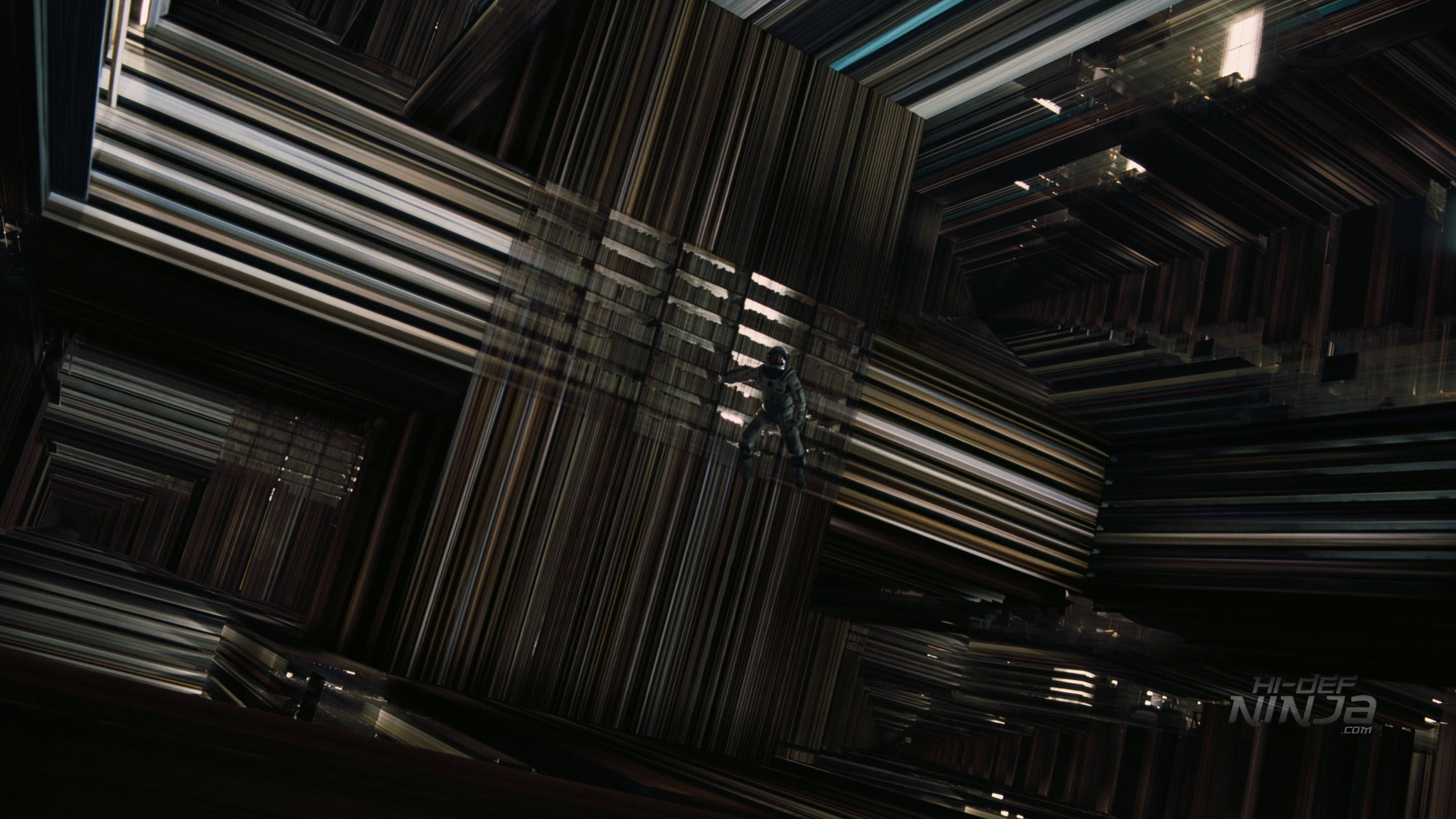 INTERSTELLAR is a breath-taking visual experience that exposes galaxy-sized holes and hits some really heavy science that will take people awhile to work through. But I’d encourage you to do so, because its imagery is so powerful, even though some will find the experience to be tedious. This is not THE DARK KNIGHT and nor should it be, for the lessons to be learned here affect all of humanity, even if the idea of love transversing space-time is a bit hard to figure out. The home experience is almost as significant, with stellar video, exceptional supplements, but an audio track that didn’t correct for the somewhat disjointed theater experience. Watching INTERSTELLAR again reminds me that smart productions like these are few and far between, and should therefore be celebrated and encouraged. Christopher Nolan doesn’t make a weird movie for weirdness sake, but instead tries to craft a very difficult concept and hits most of his targets. It comes highly recommended.
INTERSTELLAR is a breath-taking visual experience that exposes galaxy-sized holes and hits some really heavy science that will take people awhile to work through. But I’d encourage you to do so, because its imagery is so powerful, even though some will find the experience to be tedious. This is not THE DARK KNIGHT and nor should it be, for the lessons to be learned here affect all of humanity, even if the idea of love transversing space-time is a bit hard to figure out. The home experience is almost as significant, with stellar video, exceptional supplements, but an audio track that didn’t correct for the somewhat disjointed theater experience. Watching INTERSTELLAR again reminds me that smart productions like these are few and far between, and should therefore be celebrated and encouraged. Christopher Nolan doesn’t make a weird movie for weirdness sake, but instead tries to craft a very difficult concept and hits most of his targets. It comes highly recommended.
INTERSTELLAR is rated PG-13 for some intense perilous action and brief strong language and has a runtime of 169 minutes.


